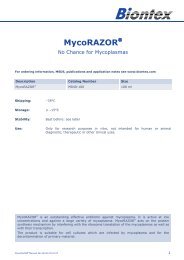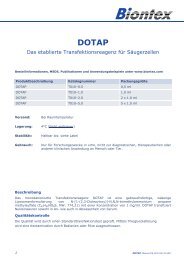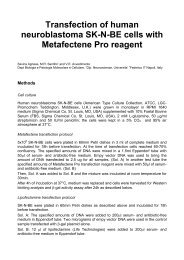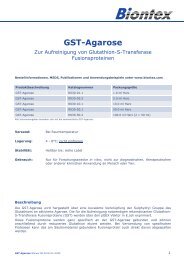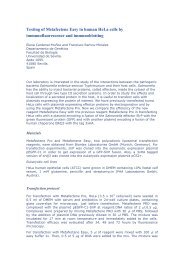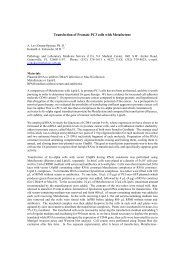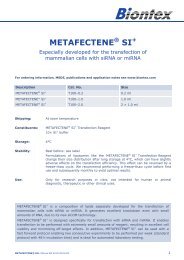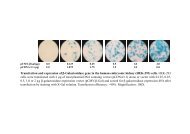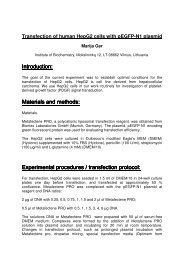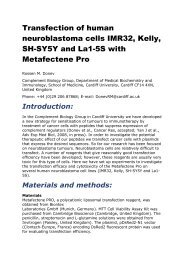Ni-NTA Agarose - Biontex Laboratories
Ni-NTA Agarose - Biontex Laboratories
Ni-NTA Agarose - Biontex Laboratories
You also want an ePaper? Increase the reach of your titles
YUMPU automatically turns print PDFs into web optimized ePapers that Google loves.
<strong>Ni</strong>-<strong>NTA</strong> <strong>Agarose</strong><br />
For purification of histidine-tagged fusion proteins<br />
For ordering information, MSDS, publications and application notes see www.biontex.com<br />
Description Cat. No. Size<br />
<strong>Ni</strong>-<strong>NTA</strong> <strong>Agarose</strong> R040-01.1 1.0 ml resin<br />
<strong>Ni</strong>-<strong>NTA</strong> <strong>Agarose</strong> R040-05.1 5.0 ml resin<br />
<strong>Ni</strong>-<strong>NTA</strong> <strong>Agarose</strong> R040-10.1 10.0 ml resin<br />
<strong>Ni</strong>-<strong>NTA</strong> <strong>Agarose</strong> R040-50.1 50.0 ml resin<br />
<strong>Ni</strong>-<strong>NTA</strong> <strong>Agarose</strong> R040-50.2 100.0 ml resin (2 × 50 ml)<br />
Volumes correspond to settled agarose resin.<br />
Shipping:<br />
At room temperature<br />
Storage:<br />
2 - 8 °C; do not freeze<br />
Stability:<br />
Best before: see label<br />
Use:<br />
Only for research purposes in vitro, not intended for human or animal<br />
diagnostic, therapeutic or other clinical uses.<br />
Description<br />
<strong>Biontex</strong> <strong>Ni</strong>-<strong>NTA</strong> <strong>Agarose</strong> provides a simple and very effective means of purifying recombinant<br />
proteins fused with a 6-fold histidine tag (His-tag). The His-tag does not usually affect the<br />
bioactivity of the protein in question, and the purification procedure is simple.<br />
The agarose consists of the tridentate chelating agent, nitrilotriacetic acid (<strong>NTA</strong>), covalently<br />
coupled to 6 % cross-linked agarose beads, and is loaded with <strong>Ni</strong> 2+ ions. Immobilized <strong>Ni</strong>ckel<br />
selectively binds exposed histidine residues and allows recombinant His-tagged proteins to be<br />
purified directly from crude bacterial lysates under either native or denaturing conditions. Resin<br />
allows batch or column purifications.<br />
<strong>Ni</strong>-<strong>NTA</strong> <strong>Agarose</strong> Manual EN 201312121403 1
Content<br />
Description................................................................................................................................. 1<br />
Content ..................................................................................................................................... 2<br />
1. General Information..................................................................................................................... 3<br />
1.1 Specifications............................................................................................................................... 3<br />
1.2 Flow Rates................................................................................................................................... 3<br />
1.3 Explanatory Remarks .................................................................................................................... 3<br />
1.4 Native or Denaturing Conditions ..................................................................................................... 3<br />
1.5 Proposal of Sample Preparation under Native Conditions ................................................................... 4<br />
Example of Native Buffer Compositions:......................................................................................... 5<br />
1.6 Proposal of Sample Preparation under Denaturing Conditions............................................................. 5<br />
Isolation of Inclusion Bodies ......................................................................................................... 5<br />
Solubilization of Inclusion Bodies................................................................................................... 5<br />
Usage of Denaturing Buffers in Working Instructions ....................................................................... 6<br />
2. Working Instructions: Batch Purification ..................................................................................... 7<br />
2.1 <strong>Biontex</strong> <strong>Ni</strong>-<strong>NTA</strong> <strong>Agarose</strong>-Preparation ............................................................................................... 7<br />
a) Elimination of the Preservative............................................................................................... 7<br />
b) Equilibration of the Resin ...................................................................................................... 7<br />
2.2 Sample Application ....................................................................................................................... 8<br />
2.3 Washing ...................................................................................................................................... 8<br />
2.4 Elution ........................................................................................................................................ 8<br />
2.5 Regeneration and Storage ............................................................................................................. 9<br />
3. Working Instructions: Gravity Purification................................................................................... 9<br />
3.1 <strong>Biontex</strong> <strong>Ni</strong>-<strong>NTA</strong> <strong>Agarose</strong>-Preparation ............................................................................................... 9<br />
3.1.1. Elimination of the Preservative ....................................................................................... 9<br />
3.1.2. Equilibration of the Pre-Packed Column ......................................................................... 10<br />
3.2 Sample Application ..................................................................................................................... 10<br />
3.3 Washing .................................................................................................................................... 11<br />
3.4 Elution ...................................................................................................................................... 11<br />
3.5 Regeneration and Storage ........................................................................................................... 11<br />
4. Working Instructions: Spin Purification ..................................................................................... 12<br />
4.1 <strong>Biontex</strong> <strong>Ni</strong>-<strong>NTA</strong> <strong>Agarose</strong> Preparation ............................................................................................. 12<br />
4.1.1. Elimination of the Preservative ..................................................................................... 12<br />
4.1.2. Equilibration of the Pre-Packed Spin Column .................................................................. 13<br />
4.2 Sample Application ..................................................................................................................... 13<br />
4.3 Washing .................................................................................................................................... 13<br />
4.4 Elution ...................................................................................................................................... 13<br />
4.5 Regeneration and Storage ........................................................................................................... 14<br />
5. Working Instructions: FPLC TM Purification ................................................................................. 14<br />
5.1 Column Packaging, Elimination of the Preservative and Equilibration of the Resin ............................... 14<br />
5.2 Sample Application ..................................................................................................................... 15<br />
5.3 Washing .................................................................................................................................... 15<br />
5.4 Elution ...................................................................................................................................... 15<br />
5.5 Regeneration and Storage ........................................................................................................... 16<br />
6. Regeneration and Storage.......................................................................................................... 16<br />
Regeneration Protocol 1 (Decontamination):................................................................................. 16<br />
Regeneration Protocol 2 (Removal of Metal Ions): ......................................................................... 16<br />
7. Miscellaneous............................................................................................................................. 17<br />
7.1 Compatibility of Reagents ............................................................................................................ 17<br />
7.2 Tips .......................................................................................................................................... 18<br />
7.3 Important Information ................................................................................................................ 18<br />
7.4 Warranty ................................................................................................................................... 18<br />
8. Related Products........................................................................................................................ 19<br />
2 <strong>Ni</strong>-<strong>NTA</strong> <strong>Agarose</strong> Manual EN 201312121403
1. General Information<br />
1.1 Specifications<br />
Applications<br />
Binding / Loading capacity<br />
Bead structure<br />
Affinity chromatography of 6×histidine-tagged fusion proteins in<br />
batch or gravity flow processes<br />
>50 mg of 6×histidine-tagged fusion protein per 1 ml agarose<br />
Cross-linked 6 % agarose<br />
Bead size Spherical, standard ca. 50 – 170 µm<br />
Max. pressure<br />
Formulation<br />
Antimicrobial agent<br />
Shelf life<br />
2.6 psi (0.18 bar)<br />
Unbuffered suspension in 30% ethanol<br />
30 % ethanol<br />
5 years (after date of certificate of analysis)<br />
Storage 2 – 8 °C<br />
1.2 Flow Rates<br />
Recommended standard-flow rate<br />
Maximum linear flow rate<br />
1 ml / min<br />
300 cm / h<br />
1.3 Explanatory Remarks<br />
Separations can be performed by batch purification, gravity flow and spin columns, or by columns<br />
attached to a low-pressure pump such as a peristaltic pump or FPLC TM -System.<br />
Elution is possible by several techniques, including lowering the pH, or by using a metal complexing<br />
agent such as imidazole or EDTA in the buffer. There is a balance between the concentration of<br />
imidazole required to elute the His-tagged protein, and the amount needed to avoid nonspecific<br />
binding of contaminants. Generally a higher imidazole concentration in the equilibration buffer will<br />
give a higher purity of protein, although it will compromise the yield.<br />
Column chromatography may be monitored at 280 nm to obtain a profile of the elution peak, thus<br />
enabling dilution of the eluate to be avoided.<br />
It is recommended that an aliquot of each step is retained for SDS-PAGE analysis. This will assist in<br />
optimizing the purification. It is also a means of monitoring the procedure to ensure that it has<br />
worked.<br />
1.4 Native or Denaturing Conditions<br />
<strong>Biontex</strong> <strong>Ni</strong>-<strong>NTA</strong> <strong>Agarose</strong> may be used under denaturing or native conditions.<br />
It is important to determine whether the His-tagged protein is soluble in the cytoplasm, or is<br />
present in inclusion bodies. If the latter, the protein must be solubilized with denaturants such as<br />
urea of guanidine hydrochloride before purification. Denaturants ensure that otherwise insoluble<br />
His-tagged proteins can be purified, and will cause a conformational change that exposes the Histag,<br />
enabling more efficient binding to the <strong>Ni</strong>-<strong>NTA</strong> <strong>Agarose</strong>. Denaturing conditions, however,<br />
generally result in the complete loss of biological and biochemical activity of the proteins being<br />
purified. It is preferable to lyse the cells in the milder denaturant, urea, so that the cell lysate can<br />
be analyzed directly on a SDS polyacrylamide gel. GuHCl is a more efficient solubilization and cell<br />
lysis reagent, however, and may be required to solubilize some proteins. Since fractions which<br />
contain GuHCl will precipitate with SDS when loaded onto an SDS polyacrylamide gel, they must<br />
either be diluted (1:6), dialyzed before analysis, or separated from GuHCl by TCA precipitation.<br />
<strong>Ni</strong>-<strong>NTA</strong> <strong>Agarose</strong> Manual EN 201312121403 3
Some membrane proteins may not be solubilized under chaotropic conditions, but may be able to<br />
be solubilized using detergents.<br />
Purification under native conditions allows the co-purification of associated proteins, and allows<br />
further study of biological or biochemical activity such as enzyme activity, antibody binding or<br />
receptor activity.<br />
If purification is to be performed under native conditions, His-tagged protein must be soluble under<br />
these conditions. However, even if the majority of His-tagged protein is present in insoluble<br />
inclusion bodies, some soluble protein may still be present and can be purified under native<br />
conditions.<br />
Purification under native conditions may result in co-purification of unrelated, untagged proteins<br />
than when denaturing conditions are employed. Nonspecific binding is minimized by adding a low<br />
concentration of imidazole to the native lysis buffer and native equilibration buffer.<br />
Note: Buffers for native conditions differ from buffers for denaturing conditions!<br />
1.5 Proposal of Sample Preparation under Native Conditions<br />
1. Collect the cells from the 'overnight' culture by centrifuging (7,000 – 8,000 x g for 10 min or<br />
4,000 x g for 15 min or 1,000 – 1,500 x g for 30 min at 4°C). The volume of culture used<br />
depends on the expression level of the desired protein. Freeze the pellet for further use.<br />
2. Thaw the cell pellet on ice for approx. 15 minutes.<br />
3. Cell lysis methods: Cell lysis can be performed using various methods<br />
a) Mechanical, such as sonication, homogenization, grinding or pressurized decomposition<br />
using the French-press principle. For these, resuspend the pellet cells in cold native<br />
resuspension buffer, using 5 volume units of resuspension buffer for each volume unit of<br />
wet pelleted cells. If using sonication or homogenization, minimize the treatment time as far<br />
as possible, use ice to cool the suspension and pulse in short bursts - typically 5 to 6 10-<br />
second pulses interspersed by 5-second breaks. Excessive ultrasound or homogenization<br />
treatment may destroy protein functions. Avoid freezing samples, as this may cause<br />
denaturization of the fusion protein and result in co-purification with the original protein.<br />
b) Cells should preferably be lysed chemically in native lysis buffer. To do this, suspend the<br />
pelleted cells in the buffer (2 - 5 ml lysis buffer per 1 g wet pelleted cells) on ice for approx.<br />
30 minutes.<br />
The lysis buffer contains 10 mM imidazole to minimize binding of untagged proteins<br />
(contaminants) and optimize purification while reducing the number of washing steps.<br />
If the fusion protein fails to bind under these conditions reduce the concentration of<br />
imidazole to 1 – 5 mM.<br />
The maximum concentration of imidazole (for strongly binding proteins) is 20 mM.<br />
4. Sonicate the suspension (approx. 10 x at 200-300 W, with 10s cooling interval between each<br />
sonication).<br />
5. If the lysate is still viscous add 5 mg/ml DNase I (or RNase I (5 µg/ml) and RNase A (10 µg/ml)<br />
of preferred) and incubate on ice for 10 - 15 min.<br />
6. Centrifuge the crude lysate at 10,000 - 12,000 x g for 15 - 30 min at 4ºC and remove the<br />
supernatant, leaving all cell debris behind. Retain a specimen of lysate (approx. 5 µl) for SDS-<br />
PAGE analysis.<br />
7. Run an SDS-PAGE analysis to determine the protein concentration.<br />
4 <strong>Ni</strong>-<strong>NTA</strong> <strong>Agarose</strong> Manual EN 201312121403
Example of Native Buffer Compositions:<br />
Native lysis buffer for chemical extraction only, must be freshly prepared<br />
50 mM NaH 2 PO 4 pH 8.0 (over NaOH) 10 mM Imidazole<br />
300 mM NaCl 1.0 mg/ml Lysozyme<br />
Native resuspension buffer (for mechanical extraction)<br />
50 mM NaH 2 PO 4 pH 8.0 (over NaOH) 10 mM Imidazole<br />
300 mM NaCl<br />
1.6 Proposal of Sample Preparation under Denaturing<br />
Conditions<br />
Cells may be lysed in either 6 M GuHCl No. 1) or 8 M urea (No. 2) denaturing lysis buffers. Urea is<br />
a milder denaturant, and the lysate can be analyzed directly by SDS-PAGE. GuHCl is a stronger<br />
denaturant and may be necessary to solubilize some proteins. Where GuHCl is used it will be<br />
necessary to either dilute (1:6) with water, or dialyze before SDS-PAGE analysis.<br />
Isolation of Inclusion Bodies<br />
1. Thaw the cell pellet from an E.coli expression culture on ice (if frozen).<br />
2. Resuspend 1 g of pelleted, wet cells in 5 ml buffer (50 mM NaH 2 PO 4 , 300 mM NaCl, 10 mM<br />
imidazole, pH 8.0) on ice.<br />
3. Pipette up and down or stir until complete resuspension is reached without visible cell<br />
aggregates.<br />
4. Add lysozyme to a final concentration of 1mg/ml.<br />
5. Stir the solution on ice for 30 min.<br />
6. Sonicate the suspension on ice according to the instructions and check the appearance of the<br />
sample after sonication. If the lysate is still viscous add 5 mg/ml DNase I and stir on ice for 15<br />
min.<br />
7. Centrifuge the crude lysate at 10,000 x g for 30 min at 4ºC to collect the inclusion bodies.<br />
8. Discard supernatant and keep pellet on ice.<br />
Solubilization of Inclusion Bodies<br />
1. Resuspend the pellet in 10 ml 50 mM NaH 2 PO 4 , 300 mM NaCl, 10 mM imidazole, pH 8.0.<br />
2. Centrifuge at 10,000 x g (30 min at 4ºC) and discard supernatant.<br />
3. Add 2.0 ml (per g wet cells) 50 mM NaH 2 PO 4 , 300 mM NaCl, 10 mM imidazole, 8 M urea pH 8.0.<br />
4. Homogenization or sonication may be necessary to resuspend the pellet.<br />
5. Dissolve the inclusion bodies by stirring on ice for 60 min.<br />
6. Centrifuge at 10,000 x g for 30 min (at 20 ºC) to eliminate insoluble material and transfer the<br />
supernatant to a clean tube.<br />
7. Centrifuge until the supernatant is clear and save it.<br />
Resuspension buffer<br />
50 mM NaH 2 PO 4 pH 8.0 (over NaOH) 300 mM NaCl<br />
10 mM Imidazole<br />
Lysis buffer (urea)<br />
Lysis buffer (GuHCl)<br />
50 mM NaH 2 PO 4 pH 8.0 (over NaOH) 50 mM NaH 2 PO 4 pH 8.0 (over NaOH)<br />
300 mM NaCl 300 mM NaCl<br />
10 mM Imidazole 10 mM Imidazole<br />
8 M Urea 6 M GuHCl<br />
<strong>Ni</strong>-<strong>NTA</strong> <strong>Agarose</strong> Manual EN 201312121403 5
Usage of Denaturing Buffers in Working Instructions<br />
The procedure is similar to purification under native conditions except that the sample and the<br />
buffers loaded on the column contain 8 M urea (or 6M GuHCl):<br />
Binding buffer (urea)<br />
Binding buffer (GuHCl)<br />
50 mM NaH 2 PO 4 pH 8,0 (over NaOH) 50 mM NaH 2 PO 4 pH 8,0 (over NaOH)<br />
10 mM Imidazole 10 mM Imidazole<br />
300 mM NaCl 300 mM NaCl<br />
8 M Urea 6 M GuHCl<br />
Washing buffer (urea)<br />
Washing buffer (GuHCl)<br />
50 mM NaH 2 PO 4 pH 8.0 (over NaOH) 50 mM NaH 2 PO 4 pH 8.0 (over NaOH)<br />
20 mM Imidazole 20 mM Imidazole<br />
300 mM NaCl 300 mM NaCl<br />
8 M urea 6 M GuHCl<br />
Elution buffer (urea)<br />
Elution buffer (GuHCl)<br />
50 mM NaH 2 PO 4 pH 8.0 (over NaOH) 50 mM NaH 2 PO 4 pH 8.0 (over NaOH)<br />
250 mM Imidazole 250 mM Imidazole<br />
300 mM NaCl 300 mM NaCl<br />
8 M Urea 6 M GuHCl<br />
Note: Due to the dissociation of urea, the pH of denaturing buffers should be adjusted<br />
immediately prior to use. Do not autoclave.<br />
6 <strong>Ni</strong>-<strong>NTA</strong> <strong>Agarose</strong> Manual EN 201312121403
2. Working Instructions: Batch Purification<br />
The following summarized procedure is adapted for the purification of His-tagged protein under<br />
native conditions.<br />
The recombinant proteins often form insoluble inclusion bodies. If this occurs the inclusion bodies<br />
need to be rendered soluble by purifying under denaturing conditions, using, for example, urea or<br />
guanidine chloride at relevant stages (see Chapter 1.4).<br />
2.1 <strong>Biontex</strong> <strong>Ni</strong>-<strong>NTA</strong> <strong>Agarose</strong>-Preparation<br />
The volume of <strong>Biontex</strong> <strong>Ni</strong>-<strong>NTA</strong> <strong>Agarose</strong> required is determined by the amount and nature of the<br />
His-tagged protein to be purified.<br />
a) Elimination of the Preservative<br />
Determine the quantity of <strong>Biontex</strong> <strong>Ni</strong>ckel <strong>NTA</strong> <strong>Agarose</strong><br />
needed for your purification, following the<br />
recommendations below.<br />
1 ml gel corresponds to 2 ml of<br />
50 % (v/v) <strong>Biontex</strong> <strong>Ni</strong>-<strong>NTA</strong><br />
<strong>Agarose</strong> suspension.<br />
Note: Binding capacity will vary for each HIS-tagged protein. The yield of HIS-tagged<br />
protein depends on various parameters such as nature of the fusion protein,<br />
expression host, culture conditions, etc. <strong>Biontex</strong> <strong>Ni</strong>-<strong>NTA</strong> <strong>Agarose</strong> has a binding<br />
capacity benchmark of > 50 mg of HIS tagged protein / ml gel.<br />
Note: Binding capacity can be affected by several factors such as sample<br />
concentration, binding buffer, or flow rate during sample application.<br />
Option A: Gently shake the bottle of <strong>Ni</strong>ckel <strong>NTA</strong> <strong>Agarose</strong> to achieve a homogeneous suspension.<br />
Immediately pipette the suspension (2 ml of <strong>Biontex</strong> <strong>Ni</strong>-<strong>NTA</strong> <strong>Agarose</strong> suspension per ml of gel<br />
volume required) into an appropriate tube. Sediment the gel by centrifuging at 500 x g for 5<br />
minutes, carefully decant the supernatant and discard it.<br />
Option B: Manually shake the bottle of resin to obtain a homogeneous suspension of beads and<br />
preservative. Invert the bottle of resin several times, filter the resin and place in a container.<br />
b) Equilibration of the Resin<br />
Add 10 bed volumes of binding buffer to equilibrate the gel by mixing thoroughly to achieve a<br />
homogeneous suspension. Sediment the gel by centrifuging at 500 x g for 5 minutes, carefully<br />
decant the supernatant and discard it.<br />
<strong>Ni</strong>-<strong>NTA</strong> <strong>Agarose</strong> Manual EN 201312121403 7
Note: Binding buffer: 50 mM NaH 2 PO 4 , 300 mM NaCl, 10 mM imidazole, pH 8.0.<br />
Binding buffer: The choice of buffer depends on the specific properties of the protein. The buffer<br />
used most frequently is phosphate (50 mM is recommended). The pH of binding buffers generally<br />
leads to neutrality (7.0 – 8.0).<br />
Note: In some cases it is necessary to increase the concentration of imidazole (1 –<br />
20 mM) to increase the selectivity of the binding of the target protein. It is<br />
important to use high purity imidazole to avoid affecting the O.D. 280 nm and the<br />
presence of agents like EDTA or citrate at all times.<br />
2.2 Sample Application<br />
Once the resin is equilibrated, the sample containing the fused protein for purification is applied<br />
(see Chapter 1.5 und 1.6).<br />
Mix the suspension gently for 30 - 60 min at room temperature.<br />
In some cases binding may be facilitated by slightly increasing contact time.<br />
Centrifuge the suspension at 500 x g for 5 minutes to sediment the resin. Carefully decant the<br />
supernatant and discard it.<br />
2.3 Washing<br />
Note: SDS-PAGE or O.D. 280 nm analyses will give a good indication of how much<br />
washing is needed.<br />
Note: Washing buffer: 50 mM NaH 2 PO 4 , 300 mM NaCl, 20 mM imidazole, pH 8.0.<br />
1. Wash the gel by adding 10 bed volumes of wash buffer.<br />
2. Invert to mix, then centrifuge the suspension at 500 x g for 5 minutes to sediment the resin.<br />
3. Carefully decant the supernatant and discard it.<br />
4. Repeat the washing step twice (total wash 3 x 10 bed volumes of binding buffer).<br />
2.4 Elution<br />
Add 1 bed volume of elution buffer to the gel. Mix thoroughly for 10 min at room temperature.<br />
Sediment the gel by centrifuging at 500 x g for 5 minutes, carefully decant or pipette the<br />
supernatant into a new tube and store on ice. Repeat the elution step twice or more and pool the<br />
fractions containing the purified protein.<br />
Note: Elution buffer: 50 mM NaH 2 PO 4 , 300 mM NaCl, 250 mM imidazole pH 8.0.<br />
A significant amount of His-tagged protein may remain bound to the resin. Conditions (volumes,<br />
times, temperatures) used for elution may vary among His-tagged proteins. Eluates should be<br />
8 <strong>Ni</strong>-<strong>NTA</strong> <strong>Agarose</strong> Manual EN 201312121403
monitored (Bradford protein assay, SDS-PAGE or measurement of absorbance at 280 nm to<br />
determine the yield of the eluted His-fused protein).<br />
For proper storage removal of the imidazole by ultrafiltration, dialysis, or precipitation with<br />
ammonium sulphate is recommended.<br />
For most of the applications it is not necessary to eliminate the His-tag. However, this elimination<br />
is necessary for certain applications such as X-ray crystallography or RMN, where the protein<br />
structure is to be determined later. For these purposes, a His-tag is usually spliced to the protein at<br />
a protease cleavage site.<br />
2.5 Regeneration and Storage<br />
See Chapter 6<br />
3. Working Instructions: Gravity Purification<br />
The following summarized procedure is adapted for the purification of His-tagged protein under<br />
native conditions.<br />
The recombinant proteins often form insoluble inclusion bodies. If this occurs the inclusion bodies<br />
need to be rendered soluble by purifying under denaturing conditions, using, for example, urea or<br />
guanidine chloride at relevant stages (see Chapter 1.4).<br />
We recommend using <strong>Biontex</strong> Empty Columns depending on total volume size (Empty L-Columns<br />
(Cat. Nº. P-50L) with capacity of 12 ml or Empty XL-Columns (Cat. Nº. P-50XL) with capacity of<br />
35 ml).<br />
Note: All solvents and product solutions may be degassed before added to a column.<br />
3.1 <strong>Biontex</strong> <strong>Ni</strong>-<strong>NTA</strong> <strong>Agarose</strong>-Preparation<br />
3.1.1. Elimination of the Preservative<br />
The volume of <strong>Biontex</strong> <strong>Ni</strong>-<strong>NTA</strong> <strong>Agarose</strong> required is determined by the amount and nature of the<br />
His-tagged protein to be purified.<br />
Note: 100 ml of the original 50%<br />
suspension corresponds to 50 ml<br />
of gel.<br />
Note: Binding capacity will vary for each HIS-tagged protein. The yield of HIS-tagged<br />
protein depends on various parameters such as the nature of the fusion protein,<br />
expression host, culture conditions, etc. <strong>Biontex</strong> <strong>Ni</strong>-<strong>NTA</strong> <strong>Agarose</strong> has a binding<br />
capacity benchmark of > 50 mg of HIS tagged protein / ml gel.<br />
Note: Binding capacity can be affected by several factors such as sample<br />
concentration, binding buffer or flow rate during sample application.<br />
<strong>Ni</strong>-<strong>NTA</strong> <strong>Agarose</strong> Manual EN 201312121403 9
1. Determine the quantity of <strong>Ni</strong>ckel <strong>NTA</strong> <strong>Agarose</strong> needed for your purification.<br />
2. Gently shake the bottle of <strong>Ni</strong>ckel <strong>NTA</strong> <strong>Agarose</strong> to achieve a homogeneous<br />
suspension. Immediately pipette sufficient suspension into an appropriate<br />
empty column.<br />
3. Remove first the upper and then the lower cap of the column, to allow<br />
elimination of the preservative by gravity flow.<br />
3.1.2. Equilibration of the Pre-Packed Column<br />
1. Equilibrate the column with 5 bed volumes of binding buffer. Add the<br />
binding buffer to the upper part of the column and ensure no air has<br />
been trapped.<br />
2. Mix manually by inverting the pre-packed column and discard the<br />
supernatant.<br />
3. Repeat the equilibration step twice.<br />
Note: Binding buffer: 50 mM NaH 2 PO 4 , 300 mM NaCl, 10 mM imidazole, pH 8.0.<br />
Binding buffer: The choice of buffer depends on the specific properties of the protein. The buffer<br />
used most frequently is phosphate (50 mM is recommended). The pH of binding buffers generally<br />
leads to neutrality (7.0 – 8.0).<br />
Note: In some cases it is necessary to vary the concentration of imidazole (1 –<br />
20 mM) to increase the selectivity of the binding of the target protein. It is<br />
important to use high purity imidazole to avoid affecting the O.D. 280 nm. It is<br />
important to avoid the presence of agents like EDTA or citrate at all times.<br />
3.2 Sample Application<br />
1. Add the sample containing the His-tagged protein to be purified through the top of the column,<br />
keeping the sample and resin in contact 30 – 60 minutes before removing the bottom cap.<br />
In some cases a slight increase of contact time may facilitate binding.<br />
2. Mix manually by inverting the pre-packed column. Remove the lower cap of the column and<br />
discard the supernatant.<br />
10 <strong>Ni</strong>-<strong>NTA</strong> <strong>Agarose</strong> Manual EN 201312121403
3.3 Washing<br />
Note: SDS-PAGE or O.D. 280 nm analysis will give a good indication of how much<br />
washing is needed.<br />
Note: Washing buffer: 50 mM NaH 2 PO 4 , 300 mM NaCl, 20 mM imidazole, pH 8.0.<br />
1. Close the column outlet using the cap.<br />
2. Add the binding buffer (10 bed volumes) through the top to eliminate all proteins that have not been<br />
retained in the column.<br />
3. Close the column inlet using the cap and mix manually by inverting the pre-packed column.<br />
4. Remove the lower cap of the column and discard the supernatant.<br />
5. Repeat the washing step twice (total wash 3 x 10 bed volumes of washing buffer).<br />
6. Retain aliquots (5 µl) for SDS-PAGE or O.D. 280 nm analysis.<br />
3.4 Elution<br />
Note: Elution buffer: 50 mM NaH 2 PO 4 , 300 mM NaCl, 250 mM<br />
imidazole pH 8.0.<br />
1. Close the column outlet using the cap.<br />
2. Add 1 bed volume of elution buffer to the column.<br />
3. Close the column inlet using the cap and mix thoroughly for 10 min at<br />
room temperature.<br />
4. Sediment the gel, remove the end cap, collect the eluate in a new tube and store on ice.<br />
5. Repeat the elution step twice and pool the collected eluates.<br />
6. Retain aliquots (5 µl) for SDS-PAGE or O.D. 280 nm analysis.<br />
It is possible that a significant amount of His-tagged protein may remain bound to the resin.<br />
Conditions (volumes, times, temperatures) used for elution may vary among His-tagged proteins.<br />
Eluates should be monitored (Bradford protein assay, SDS-PAGE or measurement of the<br />
absorbance at 280 nm to determine the yield of the eluted His-fused protein).<br />
For proper storage removal of the imidazole by ultrafiltration or dialysis is recommended.<br />
For most of the applications it is not necessary to eliminate the His-tag. However, this elimination<br />
is necessary for certain applications such as X-ray crystallography or RMN, where the protein<br />
structure is to be determined later. For these purposes, a His-tag is usually spliced to the protein,<br />
at a protease cleavage site.<br />
3.5 Regeneration and Storage<br />
See chapter 6<br />
<strong>Ni</strong>-<strong>NTA</strong> <strong>Agarose</strong> Manual EN 201312121403 11
4. Working Instructions: Spin Purification<br />
The following summarized procedure is adapted for the purification of His-tagged protein under<br />
native conditions. The recombinant proteins often form insoluble inclusion bodies. If this occurs<br />
these need to be rendered soluble by purifying under denaturing conditions, using, for example,<br />
urea or guanidine chloride at relevant stages (see Chapter 1.4).<br />
Note: All solvents and product solutions may be degassed before added to a column.<br />
The following summarized procedure is adapted to the purification of His-tagged protein in spin<br />
columns. We recommend using <strong>Biontex</strong> Empty Spin Columns (Cat. Nº. SP-50, Capacity 800 µl).<br />
This protocol requires<br />
Empty Spin Columns with<br />
inserted frits of 10 - 20<br />
mm pore size<br />
4.1 <strong>Biontex</strong> <strong>Ni</strong>-<strong>NTA</strong> <strong>Agarose</strong> Preparation<br />
4.1.1. Elimination of the Preservative<br />
The volume of <strong>Biontex</strong> <strong>Ni</strong>-<strong>NTA</strong> <strong>Agarose</strong> required is<br />
determined by the amount and nature of the His-tagged<br />
protein to be purified.<br />
Note: 100 ml of the original 50%<br />
suspension corresponds to 50 ml<br />
of gel.<br />
Note: Binding capacity will vary for each HIS-tagged protein. The yield of HIS-tagged<br />
protein depends on various parameters such as the nature of the fusion protein,<br />
expression host, culture conditions, etc. <strong>Biontex</strong> <strong>Ni</strong>-<strong>NTA</strong> <strong>Agarose</strong> has a binding<br />
capacity benchmark of > 50 mg of HIS tagged protein / ml gel.<br />
Note: Binding capacity can be affected by several factors such as sample<br />
concentration, binding buffer or flow rate during sample application.<br />
1. Determine the quantity of <strong>Ni</strong>ckel <strong>NTA</strong> <strong>Agarose</strong> needed for purification.<br />
2. Gently shake the bottle of <strong>Ni</strong>ckel <strong>NTA</strong> <strong>Agarose</strong> to achieve a homogeneous suspension.<br />
3. Immediately pipette 100 µl of the original suspension into an appropriate empty spin column.<br />
4. Remove the lower outlet cap and place the spin column in a collecting tube.<br />
5. Centrifuge at 500 x g for 30 seconds.<br />
12 <strong>Ni</strong>-<strong>NTA</strong> <strong>Agarose</strong> Manual EN 201312121403
4.1.2. Equilibration of the Pre-Packed Spin Column<br />
Note: Binding buffer: 50 mM NaH 2 PO 4 , 300 mM NaCl, 10 mM imidazole, pH 8.0.<br />
1. Equilibrate the spin column with 500 µl of binding buffer.<br />
2. Mix manually, centrifuge at 500 x g for 30 seconds and discard flowthrough.<br />
4.2 Sample Application<br />
1. Close the spin column outlet using the cap.<br />
2. Add the sample containing the His-tagged protein to be purified through the top of the spin<br />
column, keeping sample and resin in contact for 30 - 60 minutes before removing the bottom<br />
cap.<br />
In some cases a slight increase of contact time may facilitate binding. Binding<br />
capacity can be affected by several factors such as sample concentration.<br />
3. Mix manually by inverting the spin column.<br />
4. Remove the bottom cap and place the spin column in a collecting tube.<br />
5. Centrifuge at 500 x g for 30 seconds and discard the flowthrough.<br />
4.3 Washing<br />
Note: Washing buffer: 50 mM NaH 2 PO 4 , 300 mM NaCl, 20 mM imidazole, pH 8.0.<br />
Note: Wash the column with binding buffer until the O.D. 280 nm of the eluent<br />
reaches the baseline level.<br />
1. Add 500 µl washing buffer through the top to eliminate all the proteins that have not been<br />
retained in the column.<br />
2. Mix manually by inverting the spin column.<br />
3. Centrifuge at 500 x g for 30 seconds.<br />
4. Discard flowthrough.<br />
5. Repeat the washing step twice.<br />
6. Discard flowthrough between washing steps.<br />
4.4 Elution<br />
Note: Elution buffer: 50 mM NaH 2 PO 4 , 300 mM NaCl, 250 mM imidazole pH 8.0.<br />
1. Close the spin column outlet using the cap.<br />
2. Add 500 µl of elution buffer and close the lid.<br />
3. Mix thoroughly for 10 min at room temperature.<br />
4. Centrifuge the gel, remove the end cap, collect the eluate in a new tube and store on ice.<br />
<strong>Ni</strong>-<strong>NTA</strong> <strong>Agarose</strong> Manual EN 201312121403 13
5. Repeat the elution step twice.<br />
6. Pool the collected eluates.<br />
A significant amount of His tagged protein may remain bound to the resin. Conditions (volumes,<br />
times, temperatures) used for elution may vary among His-tagged proteins. Eluates should be<br />
monitored (Bradford protein assay, SDS-PAGE or measurement of the absorbance at 280 nm to<br />
determine the yield of the eluted His-fused protein).<br />
For proper storage removal of the imidazole by ultrafiltration or dialysis is recommended.<br />
For most of the applications it is not necessary to eliminate the His-tag. However, this elimination<br />
is necessary for certain applications such as X-ray crystallography or RMN, where the protein<br />
structure is to be determined later.<br />
For these purposes, a His-tag is usually spliced to the protein, at a protease cleavage site.<br />
4.5 Regeneration and Storage<br />
See chapter 6<br />
5. Working Instructions: FPLC TM Purification<br />
<strong>Biontex</strong> <strong>Ni</strong>-<strong>NTA</strong> <strong>Agarose</strong> Resin is compatible with common low pressure chromatography columns<br />
and FPLC TM applications. We recommend columns equipped with an adjustable plunger/flow<br />
adapter. Use low rates for the loading step to allow maximal binding of the His-tagged protein. The<br />
flow rate for equilibration, washing and elution can be increased to reduce the purification time<br />
(see Table 1.2).<br />
The following summarized procedure is adapted for the purification of His-tagged protein under<br />
native conditions. The recombinant proteins often form insoluble inclusion bodies. If this occurs the<br />
inclusion bodies need to be rendered soluble by purifying under denaturing conditions, using, for<br />
example, urea or guanidine chloride at relevant stages (see Chapter 1.4).<br />
Note: It is advisable to degas all the solutions before adding to the column to avoid<br />
the formation of bubbles.<br />
5.1 Column Packaging, Elimination of the Preservative and<br />
Equilibration of the Resin<br />
1. Manually shake the bottle to obtain a homogeneous suspension of <strong>Biontex</strong> <strong>Ni</strong>-<strong>NTA</strong> <strong>Agarose</strong><br />
Beads/preservative.<br />
2. Place a funnel in the top of the column and slowly run the suspension down the walls of the<br />
column.<br />
Note: It is advisable to add the suspension slowly to avoid the formation of bubbles.<br />
The product may also be degassed before adding to the column.<br />
Note: Make sure no air is trapped under the net.<br />
3. Decant the product and discard most of the residual liquid, leaving 1 cm above the column head<br />
to prevent drying out. This is done either by passing it through the column, or pipetting it from<br />
the top of the column.<br />
4. Repeat previous steps until the desired column height is obtained.<br />
14 <strong>Ni</strong>-<strong>NTA</strong> <strong>Agarose</strong> Manual EN 201312121403
5. Insert the adapter gently into the column head until it begins to displace the liquid.<br />
6. Add distilled water to the purification stream until a constant height (corresponding to the<br />
height of the column) is achieved.<br />
Note: If the desired height is not achieved, repeat steps 1. - 6.<br />
7. When a constant height has been obtained, maintain the flow by adding 5 volumes of distilled<br />
water to completely eliminate the preservative.<br />
8. Equilibrate the column with at least 5 column volumes of binding buffer until the baseline at<br />
280 nm is stable.<br />
Note: Binding buffer: 50 mM NaH 2 PO 4 , 300 mM NaCl, 10 mM imidazole, pH 8.0.<br />
5.2 Sample Application<br />
Once the resin is equilibrated, the centrifuged or filtered sample is added. In some cases a slight<br />
increase of contact time may facilitate binding. Therefore use low rates for the loading step to allow<br />
maximal binding of the His-tagged protein.<br />
Binding capacity will vary for each His-tagged protein. The yield of His-tagged<br />
protein depends on various parameters such as amino acid composition, 3-D<br />
structure, molecular weight, etc. <strong>Ni</strong>ckel <strong>NTA</strong> <strong>Agarose</strong> has an orientative binding<br />
capacity of > 50 mg/ml gel (6 x His –GFPuv, ~32 kDa)l<br />
Binding capacity can be affected by several factors such as sample concentration or<br />
the flow rate during sample application. Collect flowthrough and verify that fused<br />
protein has bound.<br />
5.3 Washing<br />
The sample must be washed with the washing buffer (10 – 20 bed volumes) or until the O.D.<br />
280 nm reaches the baseline level.<br />
Note: Washing buffer: 50 mM NaH 2 PO 4 , 300 mM NaCl, 20 mM imidazole, pH 8.0.<br />
5.4 Elution<br />
Elute the His-tagged protein with 5-10 bed volumes of elution buffer and collect the eluates on ice.<br />
Note: It is important to identify the eluates that contain a majority of pure protein<br />
(by means of SDS-PAGE & Bradford protein assay).<br />
Note: Elution buffer: 50 mM NaH 2 PO 4 , 300 mM NaCl, 250 mM imidazole, pH 8.0.<br />
For proper storage removal of the imidazole by ultrafiltration or dialysis is recommended.<br />
<strong>Ni</strong>-<strong>NTA</strong> <strong>Agarose</strong> Manual EN 201312121403 15
For most of the applications it is not necessary to eliminate the His-tag. However, this elimination<br />
is necessary for certain applications such as X-ray crystallography or RMN, where the protein<br />
structure is to be determined later.<br />
For these purposes, a His-tag is usually spliced to the protein, at a protease cleavage site.<br />
5.5 Regeneration and Storage<br />
See chapter 6<br />
6. Regeneration and Storage<br />
The resin may lose binding points during its life because some protein is retained. Hence, loss of<br />
binding capacity may be observed in successive cycles. Regeneration may be necessary to return<br />
the resin to its initial state. Regeneration involves complete elimination of the retained protein.<br />
In general, column regeneration is always necessary when changing proteins. When continuing<br />
with the same protein, regeneration is recommended when an appreciable diminution in the yield is<br />
observed. The frequency of these stages varies with the protein and the conditions used.<br />
Regeneration Protocol 1 (Decontamination):<br />
1. Solubilize and desorb contaminants by washing the resin with 0.5 M NaOH (30 min).<br />
2. Remove the NaOH solution by washing with 10 bed volumes of distilled water.<br />
3. If you are using the resin directly, wash with 10 bed volumes of 50 mM NaH 2 PO 4 , 300 mM NaCl,<br />
10 mM imidazole, pH 8.0.<br />
4. For storage wash with 2 volumes of 20 % ethanol, resuspend the resin in 20 % ethanol and<br />
store at 2 – 8 ºC.<br />
In some cases the above procedure may not be sufficient depending on the nature of the sample<br />
(for example, if the resin changes colours due to loss or reduction of nickel ions). Regeneration<br />
involves complete elimination of the metal:<br />
Regeneration Protocol 2 (Removal of Metal Ions):<br />
• Wash the resin with 10 bed volumes of distilled water.<br />
• Eliminate the metal from the resin by washing with 10 bed volumes of 100 mM EDTA, pH 8.0.<br />
• Eliminate the excess EDTA: eliminate the residual EDTA before reloading the resin with the<br />
metal by washing the column with 10 bed volumes of distilled water.<br />
• Load the resin with the corresponding metal: once the excess EDTA has been eliminated, add 2<br />
bed volumes of 100 mM metal ion aqueous solution (normally chlorides or sulphates are used).<br />
• Eliminate excess metal: wash with 10 bed volumes of distilled water.<br />
• Prepare usable resin: add 10 volumes of the binding buffer (50 mM NaH 2 PO 4 , 300 mM NaCl,<br />
10 mM imidazole, pH 8.0).<br />
• For storage, wash with 2 volumes of 20 % ethanol, resuspend the resin in 30 % ethanol and<br />
store at 2 – 8 ºC.<br />
16 <strong>Ni</strong>-<strong>NTA</strong> <strong>Agarose</strong> Manual EN 201312121403
7. Miscellaneous<br />
7.1 Compatibility of Reagents<br />
STUDIES REAGENTS COMMENTS<br />
BUFFERS:<br />
DENATURING AGENTS:<br />
ADDITIVES:<br />
DETERGENTS:<br />
• Sodium phosphate<br />
•<br />
• TRIS, HEPES, MOPS<br />
• Sodium chloride<br />
• Urea<br />
• Guanidine-HCl<br />
• Imidazole<br />
• Glycerol<br />
• EDTA<br />
• Ethanol<br />
Non-ionic detergents<br />
(Tween, Triton, Chaps etc.)<br />
• 50 mM pH 8.0 Sodium phosphate<br />
buffer is recommended.<br />
• Coordinate with metal ions,<br />
causing a decrease in binding<br />
capacity. Up to 100mM may be<br />
used.<br />
• Avoids unspecific binding (ionic<br />
interactions).<br />
• At least 0.3M should be used. Up<br />
to 2 M can be used<br />
• Solubilizes protein. Use 8 M for<br />
purification under denaturing<br />
conditions.<br />
• Solubilizes protein. Up to 6 M can<br />
be used.<br />
• Competes with the His-tagged<br />
protein.<br />
• Reduce non specific binding (20<br />
mM)<br />
• Elute the His-tagged protein (up<br />
to 100 mM).<br />
• Avoids hydrophobic interactions<br />
between proteins.<br />
• Up to 50% can be used.<br />
• Coordinates with cations, causing<br />
a decrease in capacity.<br />
• Not recommended, but up to<br />
1 mM in samples has been used<br />
successfully in some cases.<br />
• Avoids hydrophobic interactions<br />
between proteins but may<br />
precipitate proteins, causing<br />
clump clogging and low flow<br />
rates.<br />
• Up to 20% can be used.<br />
• Removes background proteins.<br />
• Up to 2% can be used.<br />
<strong>Ni</strong>-<strong>NTA</strong> <strong>Agarose</strong> Manual EN 201312121403 17
REDUCING AGENTS:<br />
• Reduced<br />
glutathione<br />
• ß-mercaptoethanol<br />
• DTT, DTE<br />
• SDS<br />
• Can reduce <strong>Ni</strong> 2+ ions at higher<br />
concentrations.<br />
• Up to 30 mM in samples has been<br />
used successfully in some cases.<br />
• Avoids formation of disulfide<br />
bonds. Can reduce <strong>Ni</strong> 2+ ions at<br />
higher concentrations.<br />
• Up to 20 mM in samples has been<br />
used successfully in some cases.<br />
• Can reduce <strong>Ni</strong> 2+ ions at higher<br />
concentrations.<br />
• Up to 10 mM in samples has been<br />
used successfully in some cases.<br />
• Avoids hydrophobic interactions<br />
between proteins.<br />
• Coordinates with cations, causing<br />
a decrease in capacity.<br />
• Not recommended, but up to<br />
0.3% in samples has been used<br />
successfully in some cases.<br />
7.2 Tips<br />
• If the lysate is very viscous, 10 µg / ml DNase I (alternatively a mixture of RNase I (5 µg/ml)<br />
und RNase A (10 µg/ml)) may be added.<br />
• Alternatively, pass the solution through a syringe with a wide gauge needle until viscosity is<br />
reduced.<br />
• Under native conditions protease inhibitors such as Pepstatin A, Bestatin, 4-(2-amino-ethyl)<br />
benzene sulphonyl fluoride (AEBSF), E-64 or phosphoramidon may be used.<br />
• Under extended treatments with reducing agents, or in processes where high concentrations of<br />
these reagents are used, reduction of the metal ion may result. This will affect the binding<br />
capacity of the resin, so these agents should be avoided. The reagents described in the<br />
Compatibility Table (see Chapter 7.1) are compatible with <strong>Biontex</strong> <strong>Ni</strong>-<strong>NTA</strong> <strong>Agarose</strong> Beads under<br />
the conditions and concentrations indicated in this table. The stability of the resin has been<br />
tested in each of the reagents separately.<br />
7.3 Important Information<br />
<strong>Biontex</strong> <strong>Ni</strong>-<strong>NTA</strong> <strong>Agarose</strong> is developed and sold for research purposes and in-vitro use only. It is not<br />
intended for human therapeutic or diagnostic purposes. Appropriate care should be exercised when<br />
handling many of the reagents described in this publication. Sepharose, ÄKTA, FPLC are registered<br />
trademarks of Amersham Pharmacia Biotech AB.<br />
7.4 Warranty<br />
<strong>Biontex</strong> guarantees the performance of <strong>Biontex</strong> <strong>Ni</strong>-<strong>NTA</strong> <strong>Agarose</strong>, when it is used in accordance with<br />
the information given in this publication, for a period of 5 years (after date of certificate of<br />
analysis). If you are not completely satisfied with the performance of the product please contact<br />
<strong>Biontex</strong> or one of its authorized distributors.<br />
18 <strong>Ni</strong>-<strong>NTA</strong> <strong>Agarose</strong> Manual EN 201312121403
8. Related Products<br />
Product<br />
METAFECTENE ®<br />
EASY+<br />
METAFECTENE ®<br />
SI+<br />
DOTAP<br />
Cat.<br />
No.<br />
T090<br />
T100<br />
T010<br />
Product<br />
Transfection<br />
METAFECTENE ®<br />
PRO<br />
METAFECTENE ®<br />
FluoR<br />
METAFECTENE ®<br />
3D-SC<br />
Cat.<br />
No.<br />
Product<br />
Cat.<br />
No.<br />
T040 METAFECTENE ® T021<br />
T050 INSECTOGENE T030<br />
T110<br />
Protein Purification<br />
<strong>Ni</strong>-<strong>NTA</strong> <strong>Agarose</strong> R040 <strong>Ni</strong>-IDA <strong>Agarose</strong> R010<br />
METAFECTENE ®<br />
3D-HG<br />
Highflow <strong>Ni</strong>-IDA<br />
<strong>Agarose</strong><br />
T120<br />
R011<br />
GST <strong>Agarose</strong> R030 Co-IDA <strong>Agarose</strong> R020<br />
Highflow Co-IDA<br />
<strong>Agarose</strong><br />
R021<br />
Empty S-Columns P-50S Empty L-Columns P-50L Empty XL-Columns P-50XL<br />
Empty Spin-<br />
Columns<br />
SP-50 Empty Cartridges C010<br />
PROTEOfectene ®<br />
E010<br />
Proteofection<br />
PROTEOfectene ®<br />
AB<br />
Cell Culture<br />
E020<br />
MycoSPY ® M030 MycoRAZOR ® M040<br />
µ-Transfection Kit<br />
VI<br />
K010<br />
Microfection Kits<br />
µ-Proteofection Kit<br />
VI<br />
K030<br />
µ-Transfection Kit<br />
VI FluoR<br />
K020<br />
µ-Proteofection Kit<br />
VI AB<br />
K040<br />
Buffer and Positive Controls<br />
1x PBS S011 EASY + buffer (10x) EA010<br />
SI + buffer (10x) SO010 R-Phycoerythrin S020<br />
Visit the <strong>Biontex</strong> website (http://www.biontex.com) and select your home country to get specific contact and ordering information.<br />
<strong>Ni</strong>-<strong>NTA</strong> <strong>Agarose</strong> Manual EN 201312121403 19
<strong>Biontex</strong> <strong>Laboratories</strong> GmbH<br />
Am Klopferspitz 19<br />
im IZB<br />
82152 Planegg/Martinsried<br />
Germany<br />
Phone: +49 (0)89 3247995-0<br />
Fax: +49 (0)89 3247995-2<br />
Fax 2: +49 (0)89 32385994<br />
E-Mail: contact@biontex.com<br />
Internet: www.biontex.com<br />
20 <strong>Ni</strong>-<strong>NTA</strong> <strong>Agarose</strong> Manual EN 201312121403


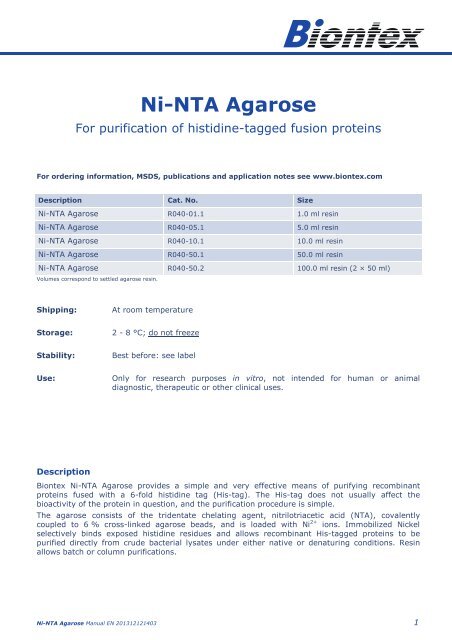
![Evaluation Metafectene Pro[1] revSI - Biontex Laboratories](https://img.yumpu.com/50763611/1/184x260/evaluation-metafectene-pro1-revsi-biontex-laboratories.jpg?quality=85)
